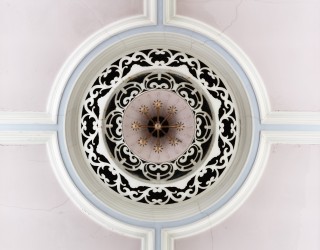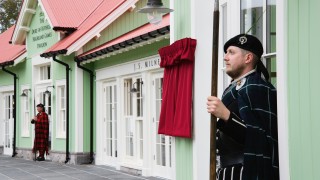Journal 29 October 2018
Restoration of Coventry’s Drapers’ Hall
Thanks to The Prince’s Foundation and the Historic Coventry Trust renovation project, the city’s Drapers’ Hall is getting a new lease of life
Most people have heard of the expression “being sent to Coventry” but few know that this may not necessarily be a bad thing. According to the Drapers’ Company London, far from being given the silent treatment, a trip to Coventry may actually be synonymous with fabric finery. “Most people think that the phrase comes from the civil war, when parliamentarians were imprisoned in St John the Baptist church and no one talked to them,” says Mark Webb, Fundraising and Development Manager at The Prince’s Foundation and founder of the charity Medieval Coventry. “But the alternative view is that if you didn’t make it in London as a draper, you were sent to Coventry, which was seen as the next best thing. It’s quite a plausible interpretation that also stresses how important the drapers were.”

And now, once again, the city and its drapers – who were involved in the wholesale and retail of cloth – are at the centre of a conversation. With the announcement of Coventry as the UK City of Culture in 2021, the city is set to see its name in lights, with its historic Drapers’ Hall at the centre of the renewal project.
Once one of the UK’s most powerful cities, Coventry’s recent history has witnessed tragedy and turbulence with wartime bombing and subsequent reconstruction rendering its medieval city centre a shadow of its former self. Now England’s ninth largest city – and capital for a short period in the mid 15th century – has become more renowned for its ring-road than its regal past and its fortunes have risen and fallen with its dominant industries, from the mighty cloth and wool trade to the manufacture of ribbons, bicycles, sewing machines, watches and cars. Although the city has struggled, its upcoming coronation in 2021 further signifies its recent revival.
The third holder of the UK City of Culture award, Coventry will have a year-long schedule of events to showcase a side of the city that has, for a long time, been undervalued. “Coventry was an incredibly cultural city – before the second world war, every pub had a room above it where there was always a poetry reading or a play or live music going on,” says Dr Geoff Willcocks, Director of Arts, Culture and Heritage at Coventry University. “But economically and culturally, the city really suffered following the downturn, and it has struggled to find its way back.”
Willcocks played a major role in Coventry landing the City of Culture title and one of the highest profile projects on the horizon is the restoration of the Drapers’ Hall. This stately Grade II*-listed building once housed the meeting place for the Worshipful Guild of Drapers but, having also been used as an air raid shelter and as a magistrates court, it has laid dormant since the 1980s. A £5 million restoration project, overseen by The Prince’s Foundation and the Historic Coventry Trust, and supported by The Prince of Wales’ Charitable Foundation, will see it transformed into a classical music and education venue and professional performance space.

“Drapers’ Hall is an incredible building that sits in the heart of the city, yet for a long time it didn’t have a job or purpose,” says Willcocks. “This project is bringing a hidden gem back to residents’ daily lives – and not just as a museum or a tourist destination, but as a lived experience for all. The city centre doesn’t have a concert venue, so we’re putting back into the heart of the city something that is truly needed.” This heritage project will do much to link the city’s past with its future through the education of a new generation of musicians in this striking space on Bayley Lane – an atmospheric street by the cathedral that was at the heart of Coventry’s influential drapery trade, which dates back to the medieval period.
As a hive of productivity in the textile trade, Coventry was the “boom town” of late medieval England according to Webb. “After the Black Death, between 1348 and 1349, at a time when other towns lost their population and were struggling, Coventry’s economy went through the roof, becoming a very important place for trade in wool and woollen cloth.” During this period, the drapers formed an important trade guild whose increasing influence saw them play a central role in city life. “Drapers represented about a third of the medieval mayors of Coventry and were right at the very pinnacle of civic life,” says Webb.

The current Drapers’ Hall, built in the Regency style, is its third incarnation and sits next to the site of the Great Drapery, which was the largest medieval cloth market outside of London. In the early 17th century, the drapers built a fine hall next to the Drapery, which became a centre for entertaining, with live music and theatre among its many functions. And according to Webb, the drapers’ influence on the city’s creative scene could stretch even further back. “There’s a lot of evidence of art and architecture funded by the drapers in Coventry,” he says. “Holy Trinity Church has a huge medieval doom painting that experts think is one of the best in the country. Some believe that it was funded by the drapers – partly because the painting is particularly opulent, meaning someone would have to have had wealth to commission it. The guilds also used to hold pageants, with each craft having their own scene from the Bible. The drapers performed the Last Judgment, so it’s fitting that they might have funded this painting.”
An exciting part of the Drapers’ Hall restoration will be the archaeological excavations around the site this autumn, which are expected to uncover some marvels from Coventry’s past. “The site is in the vicinity of Coventry castle, which many people didn’t know existed, and was at the heart of Coventry’s early history,” says Paul Thompson of Museum of London Archaeology (MOLA), which will be overseeing the work throughout the latter half of 2018. “From the medieval cloth and wool industry we could find lead cloth seals, weights and coinage but we’re also interested in the humdrum domestic rubbish – such as pottery or animal bone. We expect to find remnants from medieval or maybe even Saxon or Norman times, which should add to the wealth of knowledge of Coventry’s history.”

As its restoration gathers speed, Drapers’ Hall’s dramatic Regency interiors will be brought back to life. For Willcocks, the project represents a cultural turning point for the city. “How do we produce the next generation of culture and creators? It doesn’t happen in a vacuum – you have to put in the resources and structures,” he says. “We’re keen to reflect the huge diversity of the city and we’re making sure everything we do is relevant to young people far beyond 2021.” Webb has also noticed a change in mood that bodes well for the city’s revival. “Everybody is now sitting up and taking notice about the worth of Coventry’s heritage,” he says. “The recurring theme is one of rebirth – the city has reinvented itself time and time again with new industries.” With 2021 on the horizon, it seems that creativity will play a central role in Coventry’s latest incarnation.





